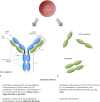Cerebrospinal fluid kappa free light chains as biomarker in multiple sclerosis-from diagnosis to prediction of disease activity
- PMID: 35133530
- PMCID: PMC9606042
- DOI: 10.1007/s10354-022-00912-7
Cerebrospinal fluid kappa free light chains as biomarker in multiple sclerosis-from diagnosis to prediction of disease activity
Abstract
Multiple sclerosis (MS) is a chronic immune-mediated disorder of the central nervous system that shows a high interindividual heterogeneity, which frequently poses challenges regarding diagnosis and prediction of disease activity. In this context, evidence of intrathecal inflammation provides an important information and might be captured by kappa free light chains (κ-FLC) in the cerebrospinal fluid (CSF). In this review, we provide an overview on what is currently known about κ‑FLC, its historical development, the available assays and current evidence on its diagnostic and prognostic value in MS. Briefly, intrathecal κ‑FLC synthesis reaches similar diagnostic accuracy compared to the well-established CSF-restricted oligoclonal bands (OCB) to identify patients with MS, and recent studies even depict its value for prediction of early MS disease activity. Furthermore, detection of κ‑FLC has significant methodological advantages in comparison to OCB detection.
Keywords: Clinically isolated syndrome; FLC index; Oligoclonal bands; Progression; Relapse.
© 2022. The Author(s).
Conflict of interest statement
H. Hegen has participated in meetings sponsored by, received speaker honoraria or travel funding from Bayer, Biogen, Merck, Novartis, Sanofi-Genzyme, Siemens, Teva, and received honoraria for acting as consultant for Biogen, Novartis and Teva. K. Berek has participated in meetings sponsored by and received travel funding from Roche, Teva and Biogen. F. Deisenhammer has participated in meetings sponsored by or received honoraria for acting as an advisor/speaker for Alexion, Almirall, Biogen, Celgene, Genzyme-Sanofi, Merck, Novartis Pharma, Roche, and Teva. His institution has received research grants from Biogen and Genzyme Sanofi. He is section editor of the MSARD Journal (Multiple Sclerosis and Related Disorders).
Figures

Similar articles
-
Free Kappa light chains in neuroinflammatory disorders: Complement rather than substitute?Acta Neurol Scand. 2018 Oct;138(4):352-358. doi: 10.1111/ane.12969. Epub 2018 Jun 13. Acta Neurol Scand. 2018. PMID: 29900542
-
Cerebrospinal fluid kappa and lambda free light chains in oligoclonal band-negative patients with suspected multiple sclerosis.Eur J Neurol. 2020 Mar;27(3):461-467. doi: 10.1111/ene.14121. Epub 2019 Dec 2. Eur J Neurol. 2020. PMID: 31710409
-
Cerebrospinal fluid free light chains compared to oligoclonal bands as biomarkers in multiple sclerosis.J Neuroimmunol. 2020 Feb 15;339:577108. doi: 10.1016/j.jneuroim.2019.577108. Epub 2019 Nov 7. J Neuroimmunol. 2020. PMID: 31743879
-
Cerebrospinal fluid kappa free light chains for the diagnosis of multiple sclerosis: A systematic review and meta-analysis.Mult Scler. 2023 Feb;29(2):169-181. doi: 10.1177/13524585221134213. Epub 2022 Dec 1. Mult Scler. 2023. PMID: 36453167 Free PMC article.
-
Oligoclonal bands and kappa free light chains: Competing parameters or complementary biomarkers?Autoimmun Rev. 2025 Apr 30;24(5):103765. doi: 10.1016/j.autrev.2025.103765. Epub 2025 Feb 11. Autoimmun Rev. 2025. PMID: 39947571 Review.
Cited by
-
Effect of long-term frozen storage on stability of kappa free light chain index.Clin Chem Lab Med. 2025 May 8;63(9):1786-1791. doi: 10.1515/cclm-2025-0125. Print 2025 Aug 26. Clin Chem Lab Med. 2025. PMID: 40434950
-
Inter-assay diagnostic accuracy of cerebrospinal fluid kappa free light chains for the diagnosis of multiple sclerosis.Front Immunol. 2024 Apr 30;15:1385231. doi: 10.3389/fimmu.2024.1385231. eCollection 2024. Front Immunol. 2024. PMID: 38745673 Free PMC article.
-
Kappa Free Light Chains in Multiple Sclerosis as a Marker of Intrathecal Humoral Response: A Sex-Disaggregated Study.Diagnostics (Basel). 2024 Dec 12;14(24):2798. doi: 10.3390/diagnostics14242798. Diagnostics (Basel). 2024. PMID: 39767159 Free PMC article.
-
Cerebrospinal fluid kappa free light chains for the diagnosis of multiple sclerosis: A consensus statement.Mult Scler. 2023 Feb;29(2):182-195. doi: 10.1177/13524585221134217. Epub 2022 Dec 17. Mult Scler. 2023. PMID: 36527368 Free PMC article.
-
[Usefulness of the kappa index in the diagnosis of multiple sclerosis and validation of reference values in the Community of Aragon].Rev Neurol. 2022 Oct 1;75(7):181-187. doi: 10.33588/rn.7507.2022266. Rev Neurol. 2022. PMID: 36169324 Free PMC article. Spanish.
References
-
- Compston A, Coles A. Multiple sclerosis. Lancet. 2002;359(9313):1221–1231. - PubMed
-
- Thompson AJ, Banwell BL, Barkhof F, Carroll WM, Coetzee T, Comi G, et al. Diagnosis of multiple sclerosis: 2017 revisions of the McDonald criteria. Lancet Neurol. 2018;17(2):162–173. - PubMed
-
- Arrambide G, Tintore M, Espejo C, Auger C, Castillo M, Río J, et al. The value of oligoclonal bands in the multiple sclerosis diagnostic criteria. Brain. 2018;141(4):1075–1084. - PubMed
-
- Ontaneda D, Tallantyre E, Kalincik T, Planchon SM, Evangelou N. Early highly effective versus escalation treatment approaches in relapsing multiple sclerosis. Lancet Neurol. 2019;18(10):973–980. - PubMed
Publication types
MeSH terms
Substances
LinkOut - more resources
Full Text Sources
Medical

